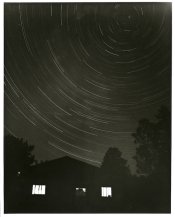where will you be shooting? If its in a cold, slightly damp environment, then you'll have a higher chance of "fogging" up the lens, and possibly condensation on the film.
what about throwing a few dessicant packets(you know those little "sacks" in shoe boxes) into the bellows, tuck them down in the folds so they don't interfere with the light path?
depending on which film you'll be using(b+w, color, which emulsion?), different films have different reciprocity characteristics, so you might want to choose depending on what you like. Provia 100F is known for its great ability on long exposures, and IIRC, the T64(Tungsten balanced) films(Kodak if you can find any anymore, T64 from Fuji now, only in 35mm/120) have almost NO reciprocity failure.
I did star trails in Joshua Tree 2 years back, and I used T64(120 sized), and the shots came out ok, but I should have chosen my framing more carefully. Its kind of a crapshoot(at least it was for me), I guess if you do star trails or long exposures all the time, you gain some sort of intuition as to how long to expose the film, but I just framed my shot at sunset, and waited until 8pm or so, and left the shutter open until 4am or so, so 8hrs total exposure time. Only enough for 1 frame/night.
if you want to shoot sheet film, you might try putting a few small pieces of tape, rolled into a reverse tube(so the sticky stuff is pointing outwards), and put that in your film holder, so the film is literally "held down" by it, film can flex/bend due to atmospheric/humidity changes quite easily.
-Dan












